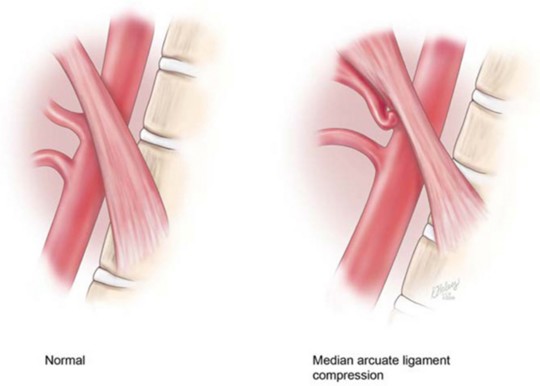(Dunbar syndrome)
Rare disease due to the presence of a fibrous band (called the median arcuate ligament) located at the level of the diaphragm that compresses the celiac artery at its emergence from the aorta and the celiac ganglion or surrounding nerves. This narrowing of the artery (which is increased in the upright position and during exhalation) reduces the blood flow to the digestive tract. It is present in 10 to 25 % of the population but causes symptoms in only 1 % of these cases.

This syndrome occurs in 2 to 5 % of patients suffering from POTS syndrome (postural orthostatic tachycardia, see this term) and is more common in cases of hypermobile Ehlers-Danlos syndrome (type III) (see this term). Signs and symptoms are often more important after a meal:
- dizziness
- tachycardia and orthostatic hypotension
- diarrhoea
- perspiration
- abdominal bloating
- decreased appetite and weight loss
- abdominal murmur (35 %)
- Doppler US examination of the upper mesenteric artery (systolic peak > 300 cm.sec during expiration); angioscan (insp/exp)
Treatment: ligament section by laparoscopic approach
Anesthetic implications:
check for possible Ehlers-Danlos syndrome; lean patient; orthostatic hypotension
References :
- Wu E.
Median arcuate ligament syndrome.
J Diagn Med Sonogr 2018; 35:141-5.
- Moak JP, Ramwell C, Fabian R, Hanumanthaiah S, Darbari A, Kane TD.
Median arcuate ligament syndrome with orthostatic intolerance: intermediate-term outcomes following surgical intervention.
J Pediatr 2021; 231:141-7.
Updated: April 2021